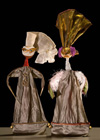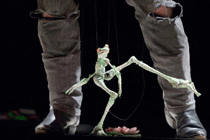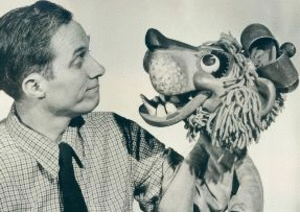Puppeteer van Dalsum got a special assignement by the UNIMA Women’s Commission: to create two special awards. The figures, objects and decors of Damiët van Dalsum are made to represent stories, to arouse illusions and to create an imaginary world in which children, and sometimes adults as well, can lose themselves.
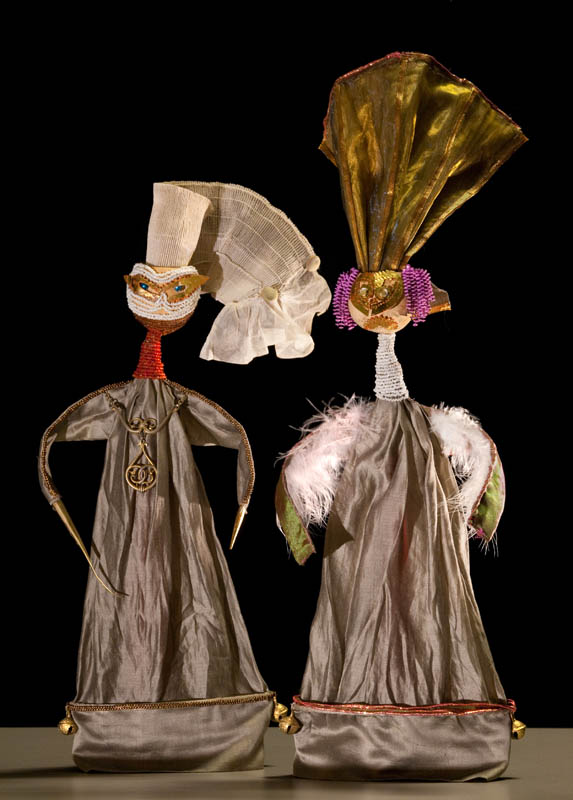
They are not meant to be shown as autonomous art objects. Besides their remarkable theatrical qualities, the puppets have a visual power of their own. It’s not easy to say what their attraction is. They’re made of almost nothing – pieces of cardboard, wire and feathers, chance objects at hand like a bell, a fan or a piece of fruit. And yet these ‘poor’ materials seem to give the impression of finely made, expensive materials. Together with this illusion of ornamental objects, there is also the association with primitive art, with magical objects that play a role in strange rituals. The unexpected combinations of different materials reminds you of surrealist fantasies. Or you may want to link the magical and the primitive with the mental world of young children, which is a source of inspiration for many artists. The atmosphere of enchantment refers to buried feelings, to a dark world of horror, fear and tension, but the puppets equally have something light-footed about them – they’re peculiar and jolly. This is what makes Van Dalsum’s objects so compelling to look at: the absurdity of all these combinations. As far as viewing pleasure, use of material and the arousal of feelings are concerned, you see no essential difference from a painting or a piece of sculpture. All the more reason, in that case, to allow them to be seen in an art context or exhibition.
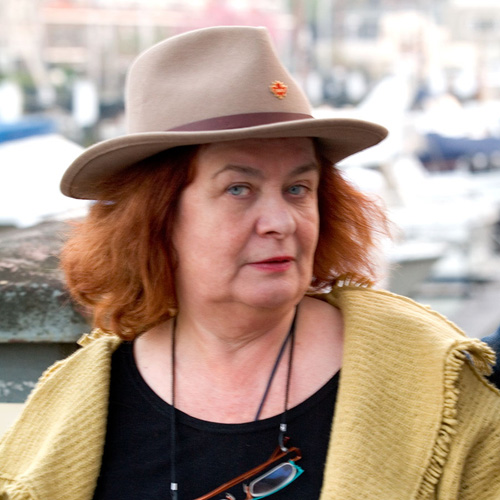
Damiet van Dalsum
The puppets by Damiët van Dalsum (1943) are inextricably bound up with her person, for each of them incorporates a part of herself. “Each puppet is a piece of my own ‘being’”, she says. A personal experience or an event in her life can lead directly to the making of a play. In 1992, after seeing on the news that German neo-nazis had burned a Turkish family she was deeply shocked and made ‘Kleine Frederik’, a children’s performance on the theme of discrimination. Damiët van Dalsum is able to get her emotions off her chest by using puppets. It is the medium she chooses to communicate with the outside world.After having studied for two years at the theatre school in Maastricht, Van Dalsum came into contact with puppetry more or less by chance. In 1965 a friend asked her to stand in during a puppet show. Improvising – there was no script – and relying on her fantasy, she began the play. It meant a real self-discovery. Puppetry would henceforth never let go of her.
A puppet play by Van Dalsum is in the first place recognisable through the individuality of the design. Unlike the typical puppet plays we are all familiar with, her puppets do not have modelled heads. And their bodies do not consist of a piece of cloth. Van Dalsum is unorthodox both in the choice of her materials and in the way they are handled. In a piece of dried fruit she finds the head of a soldier. And an upside down fan becomes the body of a woman.
Van Dalsum works associatively and intuitively when making her puppets. She lets her feelings guide her in rejecting the one form and regarding the other as the only one that is right. Her point of departure is always her inner world. When getting down to work she only has a vague and unarticulated idea of what the puppets are going to look like, but in using various materials the right form emerges from her hands.
Van Dalsum makes full use of the properties of the materials she chooses, of the fragility of the tulle and the flexibility of the spirals. At the same time she allows herself to be guided by her imagination which ‘runs away with the images’.
In the last forty years Van Dalsum has experimented with all sorts of forms of material theatre. In the late Sixties she started making and manipulating glove and stick puppets. In 1983, with the ‘Lord Wanhoop’ show, she made the change-over to marionette theatre, which continues to be her favourite form of theatre. In the same year, Van Dalsum developed in the direction of actors’ theatre with the performance ‘Op het Oog’. In ‘Dagdromen’ (1985) she herself played the leading lady amidst puppets and objects. In the children’s show ‘Kleine Frederik’ (1992) she made use of shadow play, while in 2003, in ‘Bubbelbabbelbos’, she experimented sliding figures made out of paper. ‘Club Medea’ (2005) is played in the open manner, with the puppeteers visible to the audience.
If you look at the development of her designs then you see that these have simplified over the years. Now that Van Dalsum is more familiar with the effects of different materials, she manages to convey her message in her own ‘language’ using a minimum of means. The polar bear, the daddy bear and the raccoon in ‘Hollebollebeer’, for example, consist simply of a half ball (head), a piece of streamer (body) and little bear paws. For a puppet from the ‘Club Medea’ show (2005) Van Dalsum knotted a see-through black shawl around a wooden disc with three holes. The perforated and weather-beaten wood has a strong visual effect and makes Medea’s loss of her children almost palpable.
Van Dalsum feels more affinity with children than with adults. ‘I think the child in man is often very tender and vulnerable. The adult in man, on the other hand, is hard and cold. Man allows himself to be guided too much in his life by reason, so there’s hardly any space left over for fantasy.’ In her performances for adults Van Dalsum tries to stimulate the audience to switch off their reason so they can open themselves uninhibitedly to the images. She wants her play to evoke emotions in her spectators so as to bring them closer to themselves.
Van Dalsum is not alone in her attack on the over-dominant status of reason in our culture. Dadaist and Surrealist artists were also concerned with this theme. Striking parallels with Van Dalsum’s work can be seen in their motifs and their way of working. An art historical viewpoint shows us the visual tradition that lends meaning to her work. However, these sorts of questions are not really relevant for Van Dalsum. She is simply herself.
Darja de Caluwe

